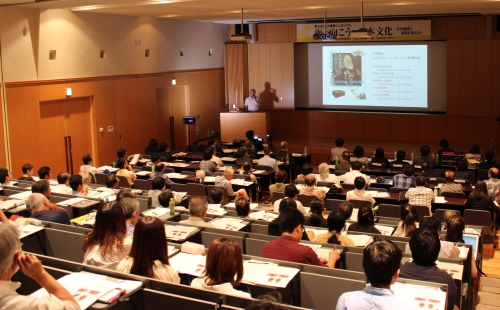No.021 - Rediscovering the Use and Value of Japan-Related Resources Recovered in the West
Rediscovering the Use and Value of Japan-Related Resources Recovered in the West
Center for Information and Public Relations, National Institutes for the Humanities
Project Assistant Professor Yuriko Kikuchi
Many historical Japanese artifacts, such as the marvelous art and craft specimens collected by Philipp Franz von Siebold in Japan, which he then took back to Europe with him, are currently held in the collections of overseas research institutes. To promote the surveying and study of these Japan-related documents and artifacts, Japan’s National Institutes for the Humanities (NIHU) has undertaken a research program called “Japan-related Documents and Artifacts Held Overseas”. Under this research program, there are four research projects and a project that promotes the dissemination of research outcomes obtained by each of the four research projects.
As a part of the research program, a symposium, “Rediscovering the Use and Value of Japan-Related Resources Recovered in the West” was held on Saturday, June 3, 2017 at Kyushu University’s Nishijin Plaza. This 30th NIHU Symposium was convened to discuss how we might raise awareness in Japan of existing Japan-related historical materials overseas and how the use of such artifacts may be encouraged in their respective source communities.
Professor Shigemi Inaga of the International Research Center for Japanese Studies (aka Nichibunken), a lead researcher of the dissemination project, took the podium to give a brief overview of the four research projects. Then, presentations were delivered from each of the four research projects on the latest research findings pertaining to the Kyushu area.
The first presentation was delivered by Associate Professor Frederik Cryns of Nichibunken, who discussed the initial encounter and friendly relations between the Dutch and the citizens of Hirado, Nagasaki. His findings were based on the results of a survey of documents from the Hirado Dutch Trading Post, now in the possession of the Nationaal Archief in The Hague. The next talk, delivered by Professor Kazuo Otomo of the National Institute of Japanese Literature, touched upon documents relating to the prohibition of Christianity in the Edo Period, now in the keeping of the Father Mario Marega Collection in the Vatican Apostolic Library, and spoke about the prospects for their study. After that, Associate Professor Kazuto Sawada of the National Museum of Japanese History, delivered a lecture based on his study of children’s boat captain costumes collected by Siebold from the Nagasaki Kunchi festival. Professor Sawada discussed how different influences of kabuki costumes could be seen on the boat captain costumes depending on when the children’s costumes were manufactured. Finally, Associate Professor Yoshiyuki Asahi of the National Institute for Japanese Language and Linguistics spoke about the Japanese linguistic culture and its characteristics as inherited by Japanese who emigrated to the Americas.
In the panel discussion, the panelists who joined Professor Inaga included researchers, government officials, and tourism industry stakeholders, such as Professor Mayuko Sano of Nichibunken/ University of Nagasaki, Associate Professor Yoshinori Iwasaki of Kyushu University, Akihiro Sato, the Director of the Cultural Affairs Division of the Oita Prefecture Board of Education, and Senior Researcher Mayuko Kono of the JTB Tourism Research & Consulting Co., with Project Assistant Professor Yuriko Kikuchi of NIHU, serving as moderator.
The panelists exchanged their observations and ideas from a variety of perspectives on possible methods for communicating and sharing research results delivered by the “Japan-related Documents and Artifacts Held Overseas” research program. These included the academic value of Japan-related documents and artifacts that are in the keeping of other countries, the importance of documenting these materials of global significance to attract interests in Japan’s rural areas, points to highlight when making use these materials as tourism resources, and the importance of curators who bridge between the academic community and society. The panelists also discussed the means of utilizing these fruits of research in ways that would revitalize local economies and societies.
Highlights of the symposium can be viewed online on YouTube (https://www.youtube.com/watch?v=rvIYXBaLfXc&t=5908s).

The symposium in session
